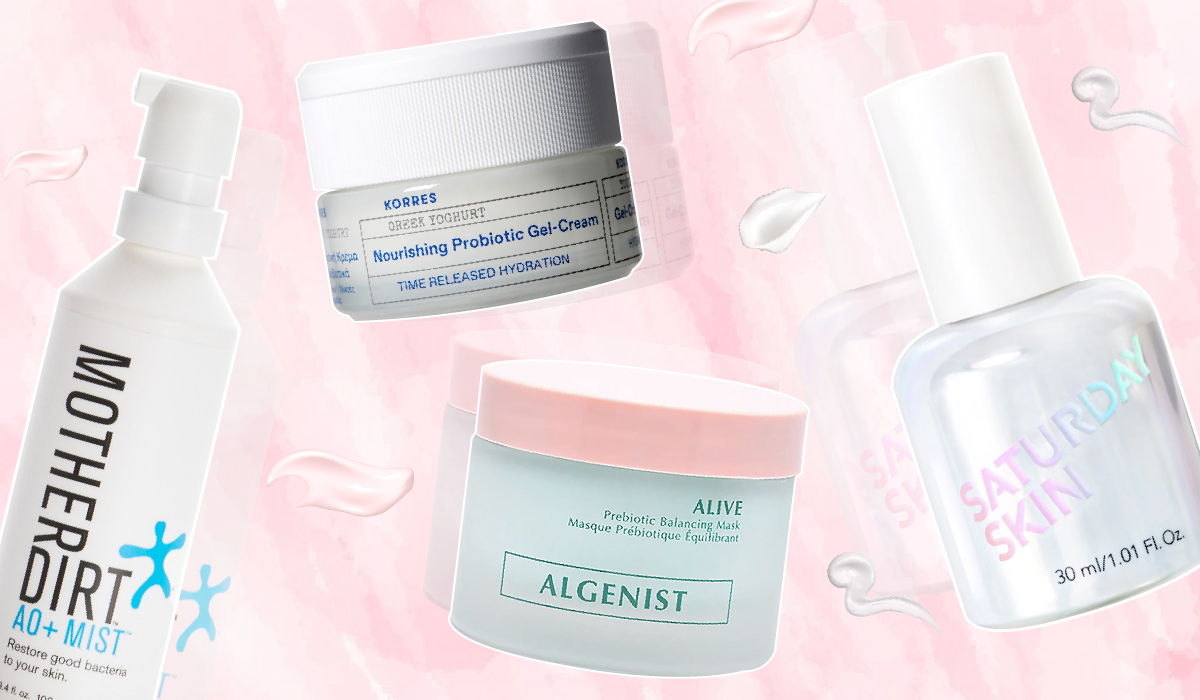Are Probiotics The Missing Step In Your Skincare Routine?

Probiotics have steadily gained momentum over the last few years, and we’re not just talking about supplements that make for a happier gut. Topical probiotics that you apply directly to your skin are becoming more commonplace, too. But what are they, exactly? And more importantly, do they even work? We’re asking the tough questions and getting some non-BS answers on the topic.
What are topical probiotics?
Let’s start by breaking down the word “probiotic.” In short, “pro” translates from Greek into “good” or “promote” and “biotic” translates to “life.” So probiotic means “good life.” And that’s exactly what probiotics do.
“They promote health and balance in our bodies and our various microbiomes, including in our gut, mouth, and on our skin,” explains Jennifer Cookson, director of research and development at Mother Dirt Skincare, a brand founded by MIT scientists and leaders in the microbiome space.
Cookson explains that we all have naturally occurring good and bad bacteria in us and on us at all times. In fact, these invisible organisms outnumber human cells by about 10 to one. Good bacteria, or probiotics, help do anything from support our immune system to keeping our gut functioning properly. Conversely, bad bacteria – when it’s overloading our systems and beating out the good stuff – can cause anything from digestive issues in our bodies to infections and inflammation on our skin.
The bottom line is that probiotics work to keep everything in balance both in and on our bodies.

How does topical probiotic skincare work exactly?
It’s really easy for our skin to become unbalanced, either from our environment (hello smog and harsh air) or from the types of products we’re using. Topical probiotics basically bring balance to our skin’s delicate ecosystem.
“Probiotic skincare utilizes microorganisms to balance the skin, which reduces breakouts and inflammation and can even assist in treating conditions such as acne, eczema, or rosacea over time,” explains Dr. Joel Schlessinger, a board-certified dermatologist based in Omaha, Nebraska. “Using probiotics in skincare can also strengthen the skin’s natural barrier function, providing extra protection against environmental aggressors and sun damage.”
In other words, well-formulated topical probiotics can improve skin clarity, reduce redness and inflammation, and balance skin so it’s neither excessively oily or dry.
Is it actually worth spending money on topical probiotics?
The million-dollar question: does topical probiotic skincare actually work? The answer is yes, but there are a couple caveats to consider before loading up your digital shopping cart. The most important consideration is that research is still underway and therefore not all products are created equally.
“There’s a significant body of research on the efficacy of gut probiotics and increasing attention to their efficacy for how they work topically – [AKA on our skin]. That said, the topical probiotics category is still in its infancy, and while we’ve learned a lot there’s still so much more that we’re going to learn as this category expands,” says Cookson. “Also, how they work depends on the individual’s microbiome and a lot of other factors, like what other products [and ingredients] are being used that contribute to the efficacy of that probiotic. There is clinical research for our products, and the others out there, that supports the use of probiotics in topical formulations.”
How to shop for – and use – topical probiotic skincare
“While both topical and ingestible probiotics are considered generally safe to use, it’s important to examine each product’s ingredients carefully. This is especially true for those prone to allergies and intolerances,” advises Dr. Schlessinger. “While it’s uncommon for probiotics to cause negative reactions, some may experience sensitivities to other ingredients in the formulation. Furthermore, these products feature live bacteria, so keep an eye out for expiration dates.”

When shopping for topical probiotics you’ll see a few familiar names – like lactobacillus and ingredients found in yogurt, fermented foods, and other digestible probiotics. Some good options include Algenist’s Alive Prebiotic Balancing Mask, $38, a vegan mask with probiotics and prebiotics (food for the good bacteria) that transforms from pink to green; Saturday Skin Bright Potion Probiotic Power Serum, $51, a concentrated anti-aging serum with pre and probiotics; and Korres Greek Yoghurt Probiotic Superdose Face Mask, $36, a super hydrating gel-cream made with real Greek yogurt.
Mother Dirt also makes topical probiotic skincare products and their AO+ Mist, $49, is the only product on the market that has a live culture of good bacteria (which means you need to keep it refrigerated).
In addition to being mindful of ingredients and expiration dates, it’s also important to consider the rest of your regimen when using topical probiotic skincare.
“In the end, the products you use, including soap, shampoo, moisturizers, SPF, makeup, etc. all contribute to the efficacy of your topical probiotic. [This is because] most products out there are formulated with preservatives to inhibit the growth of bacteria so that they have a longer shelf life,” says Cookson. “So if you use a topical probiotic and follow it up with a slathering of some non-biome-friendly lotion, then you just killed off all that good bacteria.”
For this reason, it’s important to use topical probiotics as the final step in your regimen. Also, note that these products aren’t a replacement for other products (like SPF, retinol, AHAs, and antioxidants), but are supplemental in your quest to glorious skin.
If you’re a skincare pro and terms like acids, retinol, double cleansing and skin layering are like second nature to you, then we say give them a go if you can add them to your routine. If you’re new to skincare, make sure you read the guidelines above to make sure you get the most from any probiotic skincare you try.




















Leave a comment